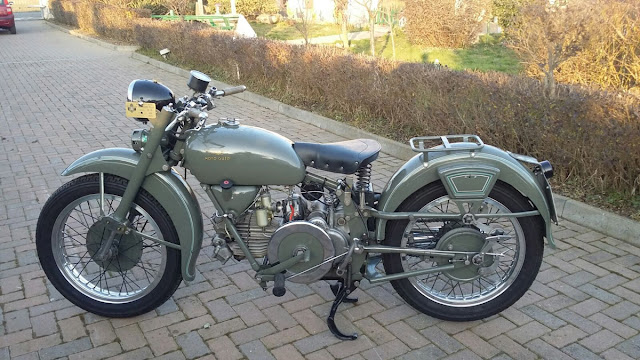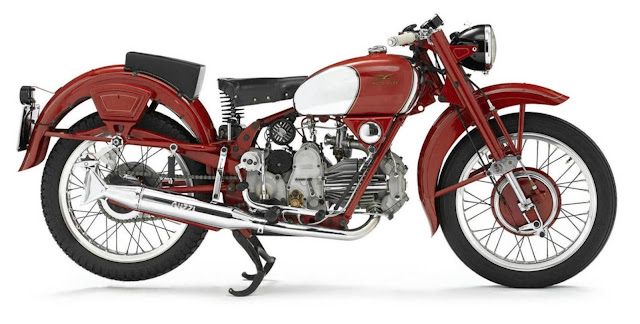Moto Guzzi Falcone
The flat single engine layout, with its big 'bacon slicer ’flywheel, had been a Moto Guzzi feature for almost 30 years when the Falcone was introduced in 1950.
Despite its racy red paintwork, this 1964 model Falcone’s raised handlebars signify that it’s a Turismo model, and not the slightly more powerful Sport.
The Falcone was the best known and longest lived of the numerous 500cc flat single models that Moto Guzzi produced for more than half a century. Its distinctive engine layout, incorporating the large ‘bacon sheer’ external flywheel, dated all the way back to the Normale model with which the firm’s founders Carlo Guzzi and Giorgio Parodi had begun production in 1921.
Guzzi’s singles had already established a strong reputation when the Falcone was introduced in 1950. The new bike was a modified version of the Astore, which had evolved from the similar GTV. Those road bikes were closely related to an exotic band of Guzzi customer road-racing singles - the Condor, Albatros and Dondolino. The Condor had been introduced in the mid-1930s. It was a street- legal competition bike with lights and silencers, and it won the Milano-Taranto race in 1940. After the Second World War the single was reintroduced with extra power and the rather unusual name of Dondolino meaning rocking-chair.
The Falcone cost half as much as the exotic Dondolino, but looked suitably sporty, with slim lines, red paintwork and low handlebars. Its 498cc pushrod-operated, alloy engine featured numerous racing developments including a four-speed gearbox from the Condor, though its crankcases were cast from aluminium, rather than lightweight electron, and its valves were enclosed rather than exposed like those of the racing engines. Peak output was 23bhp at 4500rpm. Its chassis was a uniquely Guzzi construction, based on a frame that combined steel plates with twin front downtubes. The rear suspension system was unusual, and dated back to Guzzis of the 1920s. The swingarm worked a pair of springs that sat in a box beneath the engine. Smaller rebound springs, between the engine and swingarm. worked in conjunction with adjustable friction dampers between the swingarm and rear subframe.
Most of the changes that Guzzi made to the Falcone over its long life were minor, the most significant coming in 1954 when the original model became the Falcone Sport and a new version, the Turismo, was introduced. This looked very similar and shared the same frame and suspension, but had higher handlebars, forward-set footrests and a detuned engine that produced 19bhp and reduced top speed slightly to 75mph (121km/h).
Limited production numbers
The Falcone was never produced in great numbers, with only a few hundred being built in most years. The model’s fame spread, however, helped by the success of factory-entered Falcones in longdistance events such as the Milano-Taranto and Giro d'ltalia during the early 1950s. That reputation was misleading, because those Falcones were far from standard, often using Dondolino engine parts that increased top speed to over 1 OOmph (161 km/h).
These race-winning machines were similar in ooks but much faster than the dependable Falcone :hat finally reached the end of its production in 968. Only a year later Guzzi introduced the N'uovo Falcone, combining an updated engine with _ more modern twin-shock chassis. This sold quite a ell and remained in production for another seven • ears. But it lacked the style and sporty image of ‘.he original, much loved Falcone.
Guzzi’s unique chassis dated back to the 1920s and was very old-fashioned by 1964, but the Falcone handled acceptably
The Falcone’s curiously raised headlight allowed room for a siren, as the model was popular with the Carabinieri (police).
Guzzi's Glamorous V8
Moto Guzzi had great racing success with its singles, notably in winning three 250cc world championships between 1949 and '52, and five consecutive 350cc titles from 1953. And racing inspired the most famous Guzzi of all: the 500cc V8 of 1956. Engineer Giulio Carcano's exotic liquid-cooled, quad-cam, 90-degree V8 revved to 12,000rpm, produced 72bhp and was timed at 178mph (286km/h) at the Belgian GP in 1957. But Guzzi pulled out of Grand Prix racing at the end of that season, before the V8 - pictured here with Bill Lomas, one of its original riders, at the Isle of Man TT in 1996 - had a chance to make its mark.
Specification Moto Guzzi Falcone Turismo (1958)
- Engine Air-cooled ohv pushrod two-valve single
- Capacity 498cc (88 x 82mm)
- Maximum power 19bhp @ 4300rpm
- Transmission Four-speed, chain final drive
- Frame Steel twin downtube
- Suspension Telescopic front; horizontal springs & friction dampers rear
- Brakes Drum front and rear
- Weight 368lb (167kg)
- Top speed 75mph (121 km/h)


















0 comments: